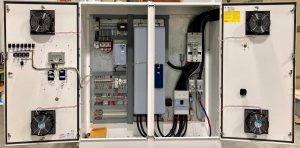Variable Frequency Drives
Frequency Drives
VFDs are used to control a wide variety of equipment from electric cranes and conveyor belts to electric motors and industrial fans. The drive takes AC power, goes through a convertor to change it to DC, then switches the current on and off quickly to control the speed of the motor. These drives are very reliable and can save significant amounts of energy over a long term use period.
variable frequency drives controls can adjust the amount of power sent to the motor on an ongoing basis based on feedback from a process. Variations in things like pressure levels, air or liquid flow rates are read by a transmitter and communicated to programmable logic controllers or PLCs which act as the go-betweens between the process and the variable speed drive. A PI loop within the drive can then alter speed on an ongoing basis. The result is precise motor control without the need for an encoder.

Many VFDs also incorporate fault reset capabilities that allow them to detect conditions that are outside of their programmed parameters and then to initiate a fault that will prevent the drive from continuing to send power to the motor. This protects the drive from damage, and it prevents downtime in a process which can cost money. The drives can also be configured to keep the motor running during a phase loss.
Variable Frequency Drives
When an AC motor is started “across the line,” it draws large amounts of current to overcome the inertia of its stationary shaft and its startup load. This is often several times the normal full load current of the motor and can cause damage to upstream electrical equipment. VFDs can be programmed to start the motor at a very low frequency and voltage to avoid this initial surge and greatly reduce resultant inrush currents.
The same control methods that can increase motor starting torque and reduce inrush currents can also extend motor life by reducing the stress on the windings during operation. When a motor is started across the line, it draws current which flexes the windings and generates heat that can shorten the lifetime of the motor. A VFD drive can start a motor at zero frequency and voltage, and then gradually build up the speed over time to magnetize the windings to minimize current and heat, which will prolong the motor’s life.
Most VFDs have acceleration and deceleration rates or ramp times pre-programmed based on their intended application (fan/pump, general purpose industrial). These default settings offer optimum energy savings with little to no additional programming required.